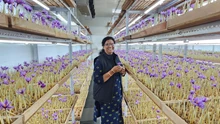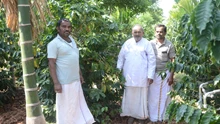
Ferula asafoetida belongs to family Apiaceae, and is commonly known as “heeng” in India. It is the dried latex (gum oleoresin) excluded from the living underground rhizome or tap root of several species of genus Ferula. It is a perennial herb with height of 1 to 1.5 meters. In India, it is found in Kashmir and some parts of Punjab. Afghanistan and Iran are the major exporter of this spice to world and to India. Heeng emits a strong pungent odour due to the presence of sulphur compounds and therefore mixed with starch and gum for selling. Heeng Kabuli Sufaid (milky white asafoetida) and Heeng Lal (red asafoetida) are the two main varieties of Heeng.
Uses and facts
It is a spice crop and mostly used in preparations of Indian food cuisines. It is said to have antibiotic properties and many health benefits. At some places, medicines are also produced from extracts of asafoetida. India doesn’t produce heeng but accounts for around 40% of world consumption.

Dr Vikram Sharma, a scientist from Bilaspur district pioneered the research on this crop in Himalaya. In 2017, he procured heeng seeds from Iran for chemical characterization, and further aims to develop seedlings from them. Sharma is of the view that this spice crop can prove as a boon for the farmers of cold desert and mid-himalayan region. CSIR- Institute of Himalayan Bioresource Technology (IHBT), Palampur was the first institute to introduce asafoetida for cultivation in India. Under the vigil of National Beaurau of Plant Genetic Resources (NBPGR), New Delhi, IHBT procured seeds of this spice crop in 2018 for analysis and trials at their centre.
Government initiatives
Governor of Himachal Pradesh, Shri Bandaru Dattatraya emphasised on the promotion of active collaborations among state agencies for large scale adoption of Asafoetida cultivation. In 2020 state budget, chief minister Jai Ram Thakur ji has proposed to promote cultivation of a new variety of heeng (Asafoetida) in high altitude areas of Lahaul-Spiti, Kinnaur and Chamba districts. Heeng cultivation will uplift farmers livelihood conditions in these areas, as it is a high demand and profitable crop.









